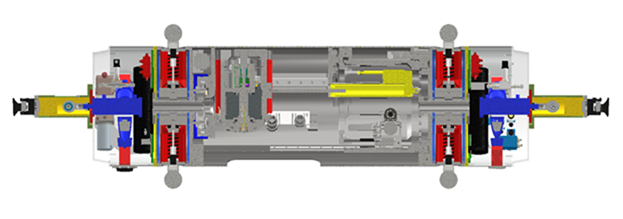WORLD-FIRST pipeline technology which will revolutionise performance and safety in industries around the world is featuring at Europe’s leading offshore pipeline technology conference which starts today.
 FSWBot technology
FSWBot technology
The development of the first ever FSWBot, Friction Stir Welding Robotic Crawler for internal repair and refurbishment of pipelines, is designed to transform the way industries deal with pipeline issues.
Led by Forth Engineering in Cumbria, the FSWBot project has been attracting attention from around the world ever since being first showcased in Aberdeen in November.
Forth Engineering is working with consortium members TWI, J4IC, Innvotek and LSBU on the project which will have a major positive impact on safety within the industry.
Sponsored by Innovate UK, the project seeks to integrate several state-of-the-art technologies including friction stir welding, milling, patch deployment and ultrasonic NDT, onto a robotic system which can be deployed to conduct repairs on pipelines without the need for the pipeline to be closed down for the duration of the repair.
If successful, it is envisaged that the system could be further developed to carry out a range of repair and fabrication tasks.
The pioneering technology is being featured in a presentation at the high-profile Offshore Pipeline Technology conference in Amsterdam from February 25-27.
It will also be presented at the Friction Stir Welding International Symposium in Kyoto, Japan in May.
Peter Routledge, Forth Engineering Project Manager, said: “The FSWBot, and the ideas, design and technology used, are interesting different industries around the world.
“We have had interest from different sectors from a range of countries, including from Saudi Arabia, America, Canada, France and Spain.
“It is creating interest in the oil, water, waste, recycling and renewables industries, all looking at how they could apply it to make them more efficient.
“We have pipeline manufacturers looking at it, and also the steel industry to see if there’s a way they can replace traditional techniques with this technology.
“We are also looking at a vertical application, in addition to the horizontal method of deployment.
“We are confident the Amsterdam conference will bring even more opportunities and more applications for the FSWBot.”
The FSWBot received funding from UK Innovate in 2018 for a consortium led by Forth Engineering to develop a ‘proof of concept’ system.
Friction stir welding is a solid state welding process which generates enough frictional heat to soften or plasticise the metal without melting it, allowing metal components to be forged together at the joint line
This system will demonstrate that a patch weld can be made in steel pipe under oil, and that a representative FSW system can be made small enough to operate in a 36-inch diameter export pipe.
The same technology could also be applied to welding in other difficult environments, for example inside fuel storage tanks and other types of pipeline.
The consortium wants to hear from companies which might have an interest in such a system, in order to consider their potential needs and applications, helping to ensure its benefits can be brought to as many industry sectors as possible while the technology is being developed.
Mark Telford, managing director of Forth, said: “We really like working with companies and organisations who come to us with a challenge and ask us to come up with a solution.
“It allows us to try different things until we come up with the method that works best, and through that partnership, and that way of working, a world-first solution is created.
“As a company we have developed a worldwide reputation for developing a range of robotic solutions for use in harsh environments.
“The tools we have developed over the years have been for, and used by, Sellafield, to successfully solve challenges in the nuclear industry. So our technology is tried and tested in harsh environments.
“There’s a fantastic opportunity for other businesses and organisations across the world, whether that’s other nuclear operations, or oil and gas, renewables, and perhaps areas we haven’t even thought of, to make use of that technology, and to share their challenges so we can develop the FSWBot in ways to help them.”
The development of the FSWBot is ongoing with the project due to be completed by the end of January, 2021.
How the FSWBot works:
The FSWBot is envisaged to be a five-segment or six-segment PIG type vehicle which will be inserted at the production end of the pipeline and will travel with the oil flow to a pre-designated spot to perform a repair.
One segment will carry the FSW machine and a steel patch dispenser, with the other segments carrying the navigation, control system, communications, NDT (non-destructive testing) and power storage/generation payloads.
On entering the pipe segment containing the pre-identified defects, the FSWBot will stop, then slowly advance until the FSW system is in place over the defect. It will then lock itself in place and confirm that it is correctly located to perform the repair.
An onboard turbine in a duct within the FSWBot will harvest energy from the oil flow within the pipe to augment any power cells carried on the system, with the duct providing through flow in the pipe.
Once energised, the FSW unit will deploy a milling tool to cut away the corroded area and prepare a pocket in the pipe wall into which a steel patch will be dispensed.
The FSW unit will then weld this patch in place and deploy the milling system again to ensure that the patch is flush with the pipe wall and will not initiate turbulent flow, nor impede the passage of subsequent cleaning or inspection PIGs.
FSWBot will then deploy NDT packages to inspect the weld for quality assurance before unclamping and moving downstream to repeat the process on any further defects.